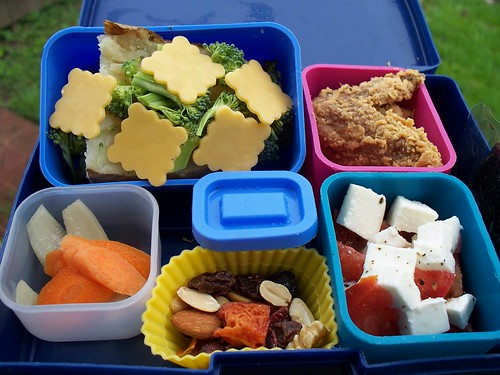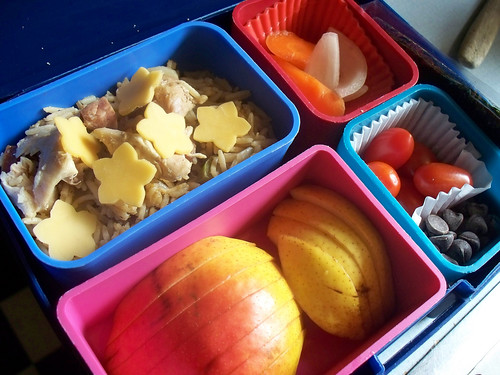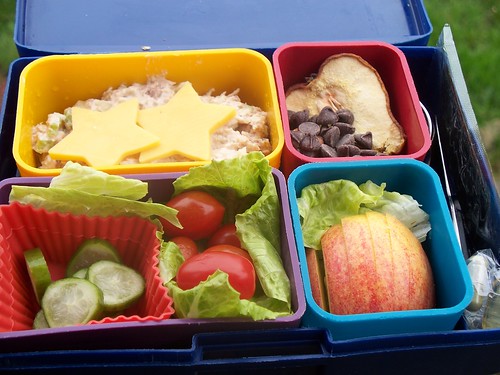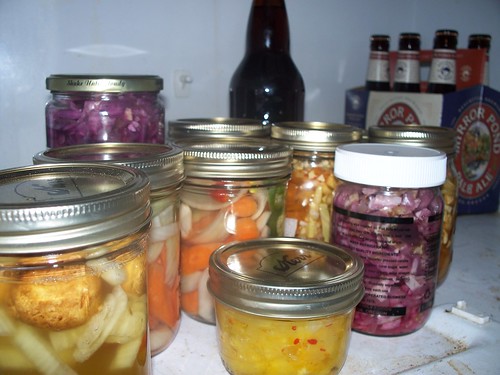The term probiotics refers to bacteria and yeast found in food that are good for your body. Our skin and intestinal tract are completely covered in bacteria and the idea is that inviting the right kind of bacteria into that system has health benefits. The human gut can contain over 2 lbs of intestinal microflora (beneficial bacteria) and they do some pretty important work there. They help digest food and create vitamins, they make it hard for bad bacteria to live there and stimulate the part of our immune system that is in our digestive system. In fact, there is more and more evidence that everything from acute intestinal upset to allergies to autism can be helped by normalizing gut bacteria and using probiotics. There are lots of good commercial probiotic foods and supplements available (as well as some not so good ones)
 but being the DIY kinda girl I am, I like to make my own.
but being the DIY kinda girl I am, I like to make my own.Yogurt, kefir and buttermilk are all very common probiotic foods. These are all fermented dairy products that are eaten while the bacteria are still alive. Vegetables and fruit can also be cultured into probiotic foods through a process called lacto fermentation. A couple months ago I wrote a tutorial for making sauerkraut, one of my favorite kinds of lacto fermented vegetable. Sauerkraut is a great way to start in on fermented vegetables because most Americans at least know what sauerkraut is and many even already like it. I've been surprised at how many of my friends are excited to try my sauerkraut because they grew up eating sauerkraut. Sauerkraut is not the only pickled vegetable out there so don't despair if you don't like the kraut.
Vegetable pickles are possibly even easier than sauerkraut and allow for as many variations as your imagination can come up with. The basic idea is to cover vegetables with a salty brine and allow the bacteria to do their thing. I'll give you a recipe-tutorial for my very favorite pickled vegetable recipe and list some of my favorite variations here and then I'll answer some common questions in a follow up post.
* * * * * * * * * * * * * *
Spicy Carrot Pickles
I like Spicy Carrot Pickles so much because they come out great every time. They are salty, spicy and a bit sour and always have a great texture. You can adjust the amount of spiciness to your liking using different kinds of peppers. These are based on the pickled carrots usually served at autentico taco places so they should be sort of familiar to a number of people.
Step One: Jar and Vegetable Prep
Find a glass jar with a tight fitting lid. A pint sized mason jars with a metal or plastic lid is great but an old pickle jar work just as well. Wash the jar and lid with hot soapy water and rinse well.
For a pint (two cup) jar you will probably use 1 1/2 - 2 medium carrots, 1/2 an onion, 2 cloves of garlic and half of a jalapeno. Have more carrots available in case I am underestimating and adjust the garlic and pepper as your family would like. I find half a jalapeno adds heat but is not
 blinding, but you may have widely different tastes. You can use a hotter pepper like Serrano or Habanero (if you dare) or a milder pepper like an Anaheim, a Hungarian pepper or a pizza pepper. Be sure to adjust the "half a pepper" accordingly to the size and heat of the pepper you choose. You could also use a pinch of red pepper flakes instead of fresh peppers.
blinding, but you may have widely different tastes. You can use a hotter pepper like Serrano or Habanero (if you dare) or a milder pepper like an Anaheim, a Hungarian pepper or a pizza pepper. Be sure to adjust the "half a pepper" accordingly to the size and heat of the pepper you choose. You could also use a pinch of red pepper flakes instead of fresh peppers.Wash the carrots but don't peel them. Slice them into long ovals by slicing on a steep diagonal to about 1/4 inch thickness. Peel and slice the garlic cloves and slice the onion longitudinally (from pole to pole, not around the equator) into 1/2 inch slices or into chunks. Slice the jalapeno into rings. Layer the vegetables in the jar to within an inch of the threads.
Step Two: The Brine
There are all kinds of recipes out there for brine strength ranging from a specific measurement in the jar to percent salinity. After reading The Ultimate Kimchi recipe and Wild Fermentation by Sandor Katz, I decided to do this the old fashioned way - use my taste buds.
I make a brine by adding salt to water until it is "too salty to be tasty, but not salty enough to make me gag." I understand that this is a very vague description of how much salt to use, but it works. I promise. Start with a teaspoon in a pint (two cups) of water and taste it. You can hardly taste the salt, right? Add another teaspoon and taste again. Then increase by half teaspoons until the water is really gross. Add a splash of water and taste again. Somewhere in between tasty and gross is the right amount of salt. It always seems a little saltier than seawater to me.
Oh - and use the right kind of salt. You should use sea salt because it is pure and has lots of trace minerals that are really good for you. I personally use RealSalt because it lists the trace minerals on the package and sells for a reasonable price. Other sea salts would be fine too. You can also use kosher salt or other salt as long as it has no iodine and no anti-caking ingredients. One caution about Celtic or grey salt - moist salt is sometimes known for carrying bacteria and mold that can ruin your ferments. If you want to use moist Celtic sea salt then you should bake it first until it is dry. Seriously, though, who needs to go through that much work for pickles. Just buy some lower quality sea salt for fermenting and keep the Celtic for sprinkling on your potatoes.
Once you have your brine made with the right kind of salt to the right saltiness then pour it over the jar full of vegetables. The brine should cover the vegetables but still be below the threads of the jar. Screw the lid on tight and set it on the counter to begin fermenting.
Step Three: Fermentation
Just like in the Kraut 101 tutorial I recommend you check your pickles every day and learn to look for signs of fermentation. The day after you make your carrot pickles open the jar and listen for popping, fizzing or hissing as you open the jar. Smell
 the contents and then taste a sip of the brine (you can take some out with a spoon or just sip it out of the jar like I do... but then again I'm pretty cavalier about things like that). Is it at all sour or fizzy or still just salty? Put the lid back on and let it sit out for another day.
the contents and then taste a sip of the brine (you can take some out with a spoon or just sip it out of the jar like I do... but then again I'm pretty cavalier about things like that). Is it at all sour or fizzy or still just salty? Put the lid back on and let it sit out for another day.It usually takes 2-5 days for signs of fermentation to really show up. Exactly how long depends on everything from the quality of your vegetables and the ambient temperature to whether you sacrificed to the proper deities. I'll address some of these variables in the next post and in the end it doesn't really matter how long it takes, just that it happens. Be patient, it will.
When your pickles are popping, fizzing or starting to taste sour then move them to the fridge. Carrot pickles usually taste best after another two or three days in the fridge (you should try them every day to see when you like them best) but will last for months without getting mushy or gross. The onion will start to get a little mushy after a month or so but whole garlic cloves are still virtually raw until at least a month in the brine.
I like to eat these pickles in anything even remotely Mexican in flavor. I love them in quesadillas and burritos as well as on salads. The pickle brine can really brighten up a soup and makes a fine salad dressing when substituted for vinegar in any recipe.
* * * * * * * * * * * * * *
Once you've run through this recipe once then you are ready to start thinking about pickling other vegetables. Here are some of my favorites.
Cucumbers: pickled cucumbers are a classic. I have used whole pickling cucumbers as well as sliced eating cucumbers (remove part of the skin, it is tough and bitter). Pack the jar with cucumbers, dill seed, garlic cloves, black peppercorns and maybe some sliced onion and/or mustard seed. Cover with brin
 e and follow the steps above.
e and follow the steps above.I didn't use cucumbers as my master recipe because I've had mixed luck with fermenting them. Cucumbers, being so watery, are at risk of getting mushy and even when they aren't mushy they never taste quite the same as vinegar pickles do. I like the fermented flavor but have not yet perfected the crunchy cucumber pickle. Some people add a grape leaf to the jar and others soak the cucumbers in salty water first. I'm going to experiment this summer and I'll let you know.
Turnips, Radishes, Not Spicy Carrots: Slice them into planks or chunks and cover with brine. Try these will dill seed and garlic or with mustard seed and red pepper flakes. Turnips tend to be a bit spicy when fermented, but are great on salads.
Beets: I recently made up a jar of sliced raw beets and carrots with no extra seasoning at all. The liquid is thick, sweet and deep red and the vegetables are now tender, sour, sweet. Fantastic.
Green Beans or Asparagus: Trim the veggies to fit in the jar and add a garlic clove and maybe one of those small, dried red chiles. Try doing the same with okra. A little juice from one of these jars is the secret to my Bloody Mary. Fantastic!
Mushrooms: White or baby 'bella mushrooms can be pickled in brine into a very tasty appetizer. I like to add black peppercorns and mustard seed as well as a small garlic clove. The mushrooms will float like corks but it has never seemed to be a problem.
Summer Relish: Last summer I made a jar of relish using canned corn, chopped green tomato, red bell pepper and onion with mustard seeds. It took a month or so for the flavor to develop but I was sad when it was gone. It was long past green tomato season and I've been daydreaming about it ever since!
Pickled Garlic: Peel the cloves, fill the jar and cover with brine. It will take months (as in 4 or 5) for the cloves to ferment fully but it will be worth it. They ferment into this mellow, garlicky, almost sweet tangy condiment. Perfect for salad dressings and topping soup. And exceptionally good for you!
Of course you can mix and match. I almost never make a jar of just one vegetable, I use whatever I have around. I will often add turnips or carrots to sauerkraut, or get lazy a
 nd throw brine over cabbage as well. Give any vegetable you have a try in the brine and see how it turns out. Experiment with seasonings, garlic, onion and different flavor combinations. You'll be amazed at what you find you like. I serve pickled vegetables with almost every meal and pretty soon you will be too!
nd throw brine over cabbage as well. Give any vegetable you have a try in the brine and see how it turns out. Experiment with seasonings, garlic, onion and different flavor combinations. You'll be amazed at what you find you like. I serve pickled vegetables with almost every meal and pretty soon you will be too!This post is part of the Real Food Wednesday Blog Carnival. Be sure to check out the other posts for more great real food ideas!
To see more photos of my lunches, others with home made pickles in them, check out my Flickr page.
Great information! I also loved your kraut tutorial. I tried making kraut once using whey and it did not turn out. Once I get a little more organized I'll try your version.
ReplyDeleteI actually had found your blog yesterday and enjoyed reading it. But I have to tell you it made me a little homesick. I spent the past 20 years living in either Beaverton or Astoria. My two oldest(grown) girls are still there and I'm happy to say that next weekend we will be going back to get our stuff that is in storage. I do miss Oregon! But I'm learning to love Wyoming. If only WY had a farmers market that was longer than 6 weeks. :)
Thanks for visiting my blog!
It's not a good idea to add whey to sauerkraut. Cabbage already has sufficient bacteria on its leaves; wild fermentation is all that's required.
DeleteThanks Alyss! I made your kraut (with purple cabbage) a few months ago, and we love it! It is my 18 month old son's favorite treat. I cut up little pieces for him at almost every meal.
ReplyDeleteIt makes me a little crazy because he snubs foods a typical toddler should love, and goes for the oddball stuff. Last week I served grass fed burgers with raw cheese, homemade mac and cheese, and sauted spinach. He refused the burger and mac and cheese, but scarfed the spinach. I guess I shouldn't complain though. :) At least he likes the healthy stuff.
I can't wait to hear how your pickles turn out. I desperately need a good pickle recipe! I can't believe they put MSG (natural flavors) in store bought pickles!
Jen
perfect timing I am making a kind of branston pickle today with cauliflower, carrot, dates, onions and zukes.....love the tip on tasting the brine! I never did that and will from now on!
ReplyDeleteMy inlaws buy the store brand bread and butter pickles I read the label and about fainted at the list of ingredients, 42 to be exact, most chemicals or unnatural additives, when I asked them if they read the label, they professed they had, so when I told them what was in it, they about fell over, but they still eat them and buy them....and let my homemade gifts to them rot! go figure! (my hubby thinks they fear I will kill them with lack of chemicals) ugh!
Thanks again!
WONDERFUL!!! I was anxiously waiting for this post, after having read your sauerkraut post!
ReplyDeleteThanks for the information, recipe and tips---I'm off to the kitchen to start making pickles of all sorts!
any fermenting ideas for a bumper crop of mango? I would love some relish or chutney but I am not looking for it to go alcoholic... maybe just a little added to regular veg for flavor? I will definitely use green mango for crunchy pickles next time I have them.
ReplyDeleteThanks for the wonderful advice. I had no idea pickling=probiotics.
ReplyDeletejon w - I've never done any pickling/fermenting of fruit that I didn't intend to go alcholic. In Nourishing Traditions Sally Fallon has a couple recipes for pickled fruit and she says you should always add whey in order to give the lacto bacteria a head start over the alcohol producing yeast. You could do a mango wine and then make vinegar out of it if you don't like to drink alcohol at all.
ReplyDeleteThis is my third year making lacto-fermented dill pickles. The first year they were mush and I ended up throwing them all out. The second year I learned the secret of keeping pickles crisp and cruchy--add an inch of Horsradish root. My dill pickles were awesome! This year I'm going to try adding a grape leaf, which is supposed to keep the pickles crisp and crunchy due to the tannins in the grage leaf. I use a salt brine, several cloves of garlic (to one's taste) onion and fresh dill.
ReplyDeleteThanks for the probiotic info, I've been wondering about that recently. I'm always in the camp of getting it from your food, not from pills.
ReplyDeleteI've been wanting to make pickles! Just needed a recipe :)
ReplyDeleteAn actual recent article on fermented vegetables. Great to see. Most of the ones I've seen online are always years old. Great to know that more people are keeping the tradition alive.
ReplyDeleteI made a batch with Gherkin cucumbers, I bought them from the farmer's market, a biodynamic grower, they were not long and thin like most gherkins but round and fat like a tomato...and guess what they are perfectly crisp in the lacto fermented batch I made, i used shallots, mustard seed, celery seed and sea salt....the liquid is sooo good I wonder if these cukes are an odd abbheration or if they can be duplicated.....getting more to try!
ReplyDeleteThanks sooo much for this post!
This is great Alyss!! I like the idea of the summer relish! Also when you say it takes several months for the garlic to fully ferment, are they sitting out or are they in the fridge? Thanks!!
ReplyDeleteis the constant checking in on them necessary or can I be lazy and just leave them alone for around 2 weeks and then enjoy?
ReplyDeletealso, is it necessary to boil the brine first? (why?)
Ben, no the constant checking isn't necessary and in fact, the fermentation probably works better with less checking. You do want to keep a bit of an eye on it, though, in case pressure builds up inside the jar. You can get some leakage, a lid thats hard to get off or even a fountain of kraut juice if you aren't careful.
ReplyDeleteI don't boil the brine for my pickles. Lots of pickle recipes call for boiling the brine because they are a) sterilizing it and b) dissolving sugar which takes a bit more work than salt. My pickles aren't sterile and don't have sugar. I have always just dissolved the sea salt in cold tap water and done just fine.
well thanks a lot great site!
ReplyDeleteThis is a FABULOUS post! Thank you so much!! Any luck getting the pickles just right? I have lots of cucumbers in my garden just waiting to be pickled :)
ReplyDeleteHey dude, was just looking through the internet looking for a bit of information and came across your site. I am very impressed by the information that you have written on this page. It tells me how good you understand this subject. Bookmarked this page, and will come back for more. My friend, YOU ROCK!!!
ReplyDeleteHi, "How Do I Get Acne" ..... Your moniker makes me think of something I learned yesterday......that probiotics (which you'll be getting in your fermented veggies) is a great acne healer !! You may have to change your name!
DeleteThanks so much for the recipes. I was wondering, approximately how long do you have to ferment the cabbage before you can start drinking the juice for the probiotics?
ReplyDeletethanks for wiritng such an easy to follow and fun read - i dont understand where the good bacteria come in though - how does soaking vegatables in salt water (whihc i would thought would kill bacteria) produce good bacteria?
ReplyDeletethanks
I always consider my probiotic yogurt as a great supplement for your good bacteria. Thanks for the recipes, too. Nice new and healthy ideas to try at home.
ReplyDeleteLove, love, love everything about this. Can't wait to start fermenting foods myself. :)
ReplyDeleteThanks for sharing!
Hi this one is great and is really a good post. I think it will help me a lot in the related stuff and is very much useful for me. Very well written I appreciate & must say good job..
ReplyDeletenaturalfactors
I admire the valuable information you offer in your articles. I will bookmark your blog and have my children check up here often. I am quite sure they will learn lots of new stuff here than anybody else! 5 hour energy
ReplyDeleteEven if you do everything in your power to restore GI health, it’s still possible to experience some side effects as a result of the antibiotics treatment.
ReplyDeletePay attention to the signals that your body sends. Some of the most common issues that result from a treatment with antibiotics include diarrhea, nausea, abdominal pain, vaginal yeast infections, headaches, dizziness and changes in taste.
thanks for sharing.
ReplyDeleteHuman growth hormone (HGH) production is essential for so many vital processes in the human body. The problem with HGH is that its quantity tends to decrease as a person ages.
ReplyDeleteHGH injections were considered one of the best methods for maintaining high HGH levels. These injections, however, tend to be quite costly. HGH production can also be boosted in natural ways.
Certain foods have the power to stimulate the pituitary gland and affect hormone levels. Here are some of the ingredients you should be adding to your meals in an attempt to experience an all-natural HGH boost. desiring hypergh14x review
Many relationships fail because of sexual problems. The reason is that men suffering from ED distance themselves. They stop sharing, they stop seeking proximity. The partners feel clueless and they have no idea how to help. fuller prosolution plus
ReplyDeleteThis comment has been removed by the author.
ReplyDeleteStronger hair and more youthful skin: growth hormone regulates collagen and protein synthesis. This is why HGH can be used to maintain the youthful appearance of the skin and to keep hair shiny. Both of these effects have boosted the popularity of HGH among people who want to turn back the hands of time. trustworthy vigrx plus site
ReplyDeletePeople who consume larger quantities of alcohol need sufficient amounts of l-valine in their system. The amino acid can correct some of the severe nutritional deficiencies that result from alcoholism and even from drug abuse. defining vigrx plus website
ReplyDeleteWell, for me uk doctor for ED did a wonderful job everytime. You can buy them from UK without an prescription now!
ReplyDeleteVery informative. Thank you!
ReplyDeleteWow what a great information you have shared!
ReplyDeleteWe are leading supplier of Sleeping tablets in UK.
Clonazepam 2 mg UK
Buy tramadol 100 mg in UK
Lorazepam UK
diazepam 10mg UK
Nice post. Well what can I say is that these is an interesting and very informative topic on food that kills bacteria in stomach
ReplyDelete인천출장샵
ReplyDeleteI like it when people come together and share many thoughts. Great website, continue the Excellent work!
ReplyDeletenice post. Buy Propecia Online
ReplyDeletekralbet
ReplyDeletebetpark
tipobet
slot siteleri
kibris bahis siteleri
poker siteleri
bonus veren siteler
mobil ödeme bahis
betmatik
ERX
شركة مكافحة حشرات بالخبر y2gcj1bi7i
ReplyDeleteشركة مكافحة بق الفراش بالجبيل W4lObgoaT4
ReplyDeleteProbiotics may help reduce the frequency and severity of colds and flu. Probiotik
ReplyDeleteشركة عزل اسطح بالجبيل
ReplyDeletevoVWMA5rRO
شركة عزل اسطح بالجبيل
ReplyDeleteXSNiVzxvBt
شركة صيانة مكيفات بالاحساء
ReplyDeleteCZDUT6byaZ